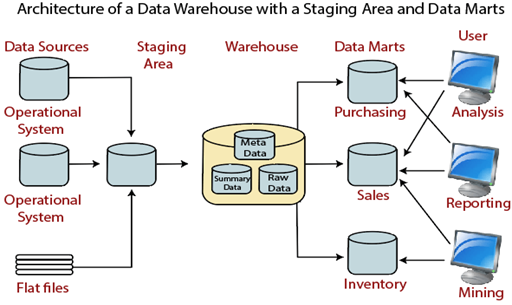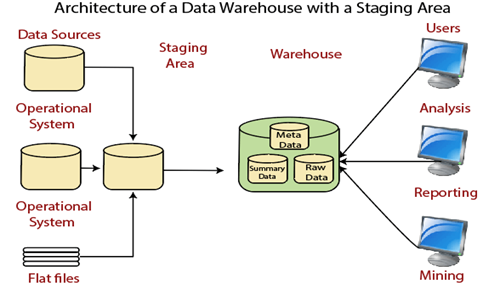Data Warehouse Architecture: What it is, Stages and Types.
21 September 2023
|
Cloud computing is a technological breakthrough in the business world, allowing organizations to easily store and retrieve data about customers, products and services. Using this data organizations can take quick and more informed business decisions.
Businesses around the world have started using data warehousing technology to retrieve and store data from various business operations. Data warehousing has become the core source for various business intelligence (BI) and analytical tools. Using the data resided in data warehouse systems organizations can stay updated on current market situations and scale quickly.
The selection of Data warehouse architecture plays an important role in the success of data warehouse platforms. There are different data warehouse architectures available and choosing the right one would help you in moving in the right direction. This blog has been designed to provide you a complete overview of Data warehouse architecture, its types and best practices to be followed.

What is Data Warehouse Architecture?
Data warehouse architecture is a framework designed to collect and store organizational data. It gathers the raw data, cleans it and arranges it in a structured format that is easy to access. Each data warehouse is unique and consists of some standard components.
The design of a data warehouse architecture largely depends on the specific data storage needs of businesses.
Elevate your career in data warehousing with our Microsoft Data Warehousing Training.
Below mentioned are the three typical data warehouse architectures designs:
- Data Warehouse Architecture: Basic
- Data Warehouse Architecture: With Staging Area
- Data Warehouse Architecture: With Staging Area and Data Marts
1) Data Warehouse Architecture: Basic
The following above diagram gives you an overview of the basic design of data warehouse architecture.

Following are the components of a basic data warehouse architecture design:
Operational System: It acts as a methodology in a data warehouse and used as a system to process the regular transactions of an organization.
Flat Files: Flat files hold a system of files that stores the transactional data. Each file in the system must be assigned a unique name.
Meta Data: Metadata data in a data warehouse is defined as a set of data used to provide information about other data.
End-User access tools: The core intention behind using a data warehouse system is to provide appropriate information to the business users for making strategic decisions. To interact with the data warehouse systems, business users use end-client access tools.
Following are some of the widely used end-user access tools:
- Application Development Tools
- Reporting and Query Tools
- Online Analytical Processing Tools
- Executive Information Systems Tools
- Data Mining Tools
2) Data Warehouse Architecture: With Staging Area
In this architectural design, the data should be cleaned and processed before transferring it into the warehouse. By default, the staging area processes the data before allowing it into the data warehouse. We can also have a chance to process the data programmatically.

3) Data Warehouse Architecture: With Staging Area and Data Marts
Sometimes there may be a need to customize warehouse architecture into different groups within the organization. In order to execute this customization process, data marts help us. A data mart is a part of a data warehouse that supplies information for conducting analysis on a section, department, unit or operation in the company. For instance payroll, sales, production, etc.
The following diagram shows how purchases, stocks and sales can be separated using a data mart. This allows the users to conduct a deeper analysis of the targeted information and helps them with the right insights to make valid decisions.
Types of Data Warehouse Architectures
- Single-Tier Architecture
- Two-Tier Architecture
- Three- Tier Architecture
Single-Tier Architecture:
The single-tier architecture minimizes data redundancy and produces a dense set of data. Though it minimizes the data redundancy, it failed to meet the complex data warehousing requirements of businesses.
Two-Tier Architecture
The two-tier architecture separates data warehouses and physically available sources.
In contrast to the single-tier architecture, it uses a system as well as a database server. In general, the two-tier architecture is widely used by small and medium-size organizations along with the data mart server. It gives optimum performance to organize and store data. The two-tier architecture is not flexible to scale and supports only a limited number of users.
Three-Tier Architecture:
The three-tier architecture is a popular and widely used data warehouse architecture. It consists of three layers which are the source layer, the reconciled layer and the data warehouse layer.
The reconciled layer creates a standard data model for the whole enterprise. It also eliminates various challenges associated with data extraction, data integration, etc. Sometimes the reconciled layer is also deployed to execute some operational tasks such as producing daily reports. This architecture is best suitable for enterprise-wide systems. The biggest pitfall of this three-tier architecture is that it stores the extra storage space and makes the analytical tools a bit slower from being real-time.
Best Practices for data warehouse design: Following are some of the standard points suggested by experts while designing data warehouse architecture.
- Use optimized data warehouse models for information retrieval.
- Select the right design approach as a top-down and bottom-up approach.
- Make sure the data is processed quickly and accurately.
- Choose the right approach for the data gathering and cleansing process for your data warehouse.
- Build an effective metadata architecture that is flexible enough to share metadata between components of Data Warehouse.
- Consider deploying the ODS model when the information retrieval process is associated with multiple sources.
Summary: The selection of the right data warehouse architecture is very essential to store, manage and access the business information. Hope this blog has provided you with a clear overview of different types of data warehouse architectures and their advantages and disadvantages.
If you wish to master learning end-to-end Microsoft Data warehouse concepts you can check out our Microsoft Data Warehousing Training. Happy learning!
Suggested blogs
Recent blogs

21 February 2025
|
06 February 2025
|